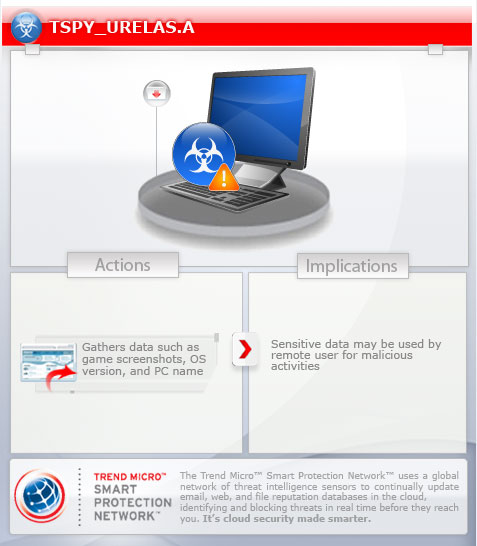TSPY_URELAS.A
Trojan:Win32/Urelas.C (Microsoft), Spyware.Keylogger (Symantec), Trojan.Win32.Urelas.a (Sunbelt)
Windows 2000, Windows Server 2003, Windows XP (32-bit, 64-bit), Windows Vista (32-bit, 64-bit), Windows 7 (32-bit, 64-bit)


Threat Type: Spyware
Destructiveness: No
Encrypted: No
In the wild: Yes
OVERVIEW
Downloaded from the Internet, Dropped by other malware
This spyware monitors and captures screenshots of specific games. It sends the stolen information its C&C server. This may lead to exposure of gaming credentials.
To get a one-glance comprehensive view of the behavior of this Spyware, refer to the Threat Diagram shown below.

This spyware arrives on a system as a file dropped by other malware or as a file downloaded unknowingly by users when visiting malicious sites.
It deletes the initially executed copy of itself.
TECHNICAL DETAILS
1,319,936 bytes
EXE
Yes
03 Jan 2013
Connects to URLs/IPs
Arrival Details
This spyware arrives on a system as a file dropped by other malware or as a file downloaded unknowingly by users when visiting malicious sites.
Installation
This spyware drops the following copies of itself into the affected system and executes them:
- %User Temp%\{malware file name}.exe
- %User Temp%\{malware file name}_test.tgs
(Note: %User Temp% is the current user's Temp folder, which is usually C:\Documents and Settings\{user name}\Local Settings\Temp on Windows 2000, XP, and Server 2003, or C:\Users\{user name}\AppData\Local\Temp on Windows Vista and 7.)
It drops the following file(s)/component(s):
- {Malware Path}\$$Windows$$.bat - used to delete the initially executed malware copy. This is also deleted after execution
It uses the following names for the copies it drops:
- svchost
- svcsg
- smse
- service
- lssas
- comine
- explorer
- spoolvs
- ctfmom
- taskmgr
- algs
- system
Information Theft
This spyware gathers the following data:
- Game screenshots
- Operating system version
- Computer name
Other Details
This spyware deletes the initially executed copy of itself
NOTES:
This spyware captures screenshots by monitoring the following game-related processes:
- Baduki.exe
- DuelPoker.exe
- FNF.exe
- highlow2.exe
- HOOLA3.EXE
- LASPOKER.exe
- poker7.exe
- RealBaduki.exe
It sends the information it gathers to the following remote sites:
- {BLOCKED}r.{BLOCKED}e2012.com
SOLUTION
9.300
9.634.03
03 Jan 2013
9.635.00
03 Jan 2013
Step 1
Before doing any scans, Windows XP, Windows Vista, and Windows 7 users must disable System Restore to allow full scanning of their computers.
Step 2
Identify and terminate files detected as TSPY_URELAS.A
- Windows Task Manager may not display all running processes. In this case, please use a third-party process viewer, preferably Process Explorer, to terminate the malware/grayware/spyware file. You may download the said tool here.
- If the detected file is displayed in either Windows Task Manager or Process Explorer but you cannot delete it, restart your computer in safe mode. To do this, refer to this link for the complete steps.
- If the detected file is not displayed in either Windows Task Manager or Process Explorer, continue doing the next steps.
Step 3
Search and delete the file detected as TSPY_URELAS.A
Step 4
Scan your computer with your Trend Micro product to delete files detected as TSPY_URELAS.A. If the detected files have already been cleaned, deleted, or quarantined by your Trend Micro product, no further step is required. You may opt to simply delete the quarantined files. Please check this Knowledge Base page for more information.
Did this description help? Tell us how we did.

